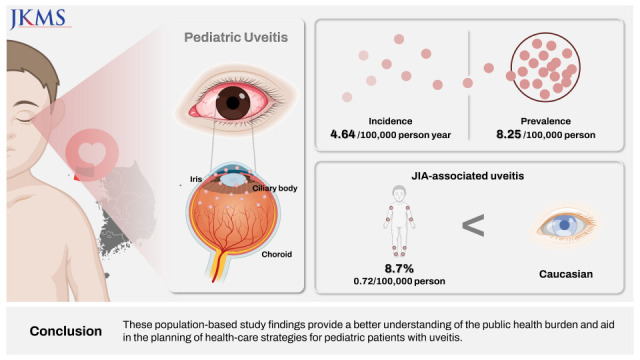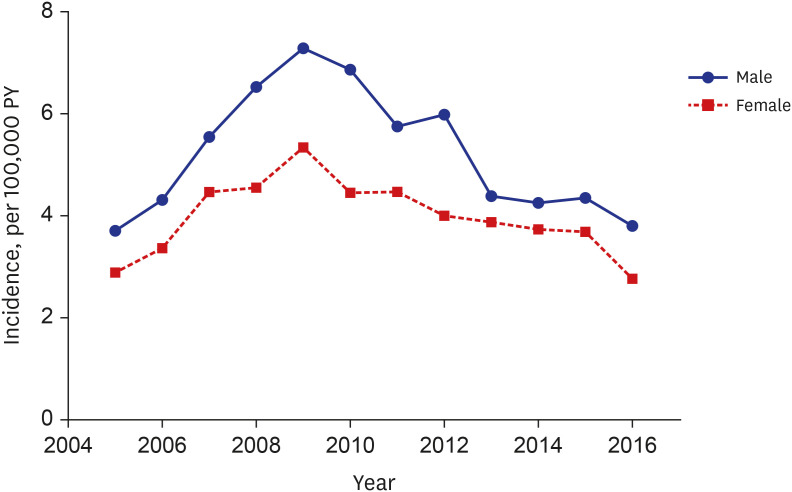1. Jabs DA, Nussenblatt RB, Rosenbaum JT. Standardization of Uveitis Nomenclature (SUN) Working Group. Standardization of uveitis nomenclature for reporting clinical data. Results of the first international workshop. Am J Ophthalmol. 2005; 140(3):509–516. PMID:
16196117.
2. BenEzra D, Cohen E, Maftzir G. Uveitis in children and adolescents. Br J Ophthalmol. 2005; 89(4):444–448. PMID:
15774921.
3. Nagpal A, Leigh JF, Acharya NR. Epidemiology of uveitis in children. Int Ophthalmol Clin. 2008; 48(3):1–7.
4. Edelsten C, Reddy MA, Stanford MR, Graham EM. Visual loss associated with pediatric uveitis in English primary and referral centers. Am J Ophthalmol. 2003; 135(5):676–680. PMID:
12719076.
5. Rosenberg KD, Feuer WJ, Davis JL. Ocular complications of pediatric uveitis. Ophthalmology. 2004; 111(12):2299–2306. PMID:
15582090.
6. Saari KM, Päivönsalo-Hietanen T, Vaahtoranta-Lehtonen H, Tuominen J, Sillanpää M. Epidemiology of endogenous uveitis in south-western Finland. Acta Ophthalmol Scand. 1995; 73(4):345–349. PMID:
8646582.
7. Shin Y, Kang JM, Lee J, Lee CS, Lee SC, Ahn JG. Epidemiology of pediatric uveitis and associated systemic diseases. Pediatr Rheumatol Online J. 2021; 19(1):48. PMID:
33794945.
8. Rothova A, Buitenhuis HJ, Meenken C, Brinkman CJ, Linssen A, Alberts C, et al. Uveitis and systemic disease. Br J Ophthalmol. 1992; 76(3):137–141. PMID:
1540555.
9. Burns JC, Joffe L, Sargent RA, Glode MP. Anterior uveitis associated with Kawasaki syndrome. Pediatr Infect Dis. 1985; 4(3):258–261. PMID:
4039819.
10. Kim M, Kim SY. Anterior uveitis associated with Kawasaki disease-and the ophthalmologist’s role. J Korean Ophthalmol Soc. 2016; 57(2):296–301.
12. Rim TH, Kim SS, Ham DI, Yu SY, Chung EJ, Lee SC, et al. Incidence and prevalence of uveitis in South Korea: a nationwide cohort study. Br J Ophthalmol. 2018; 102(1):79–83. PMID:
28596287.
13. Seepongphun U, Sittivarakul W, Dangboon W, Chotipanvithayakul R. The pattern of uveitis in a pediatric population at a tertiary center in Thailand. Ocul Immunol Inflamm. 2021.
14. Pilly B, Heath G, Tschuor P, Lightman S, Gale RP. Overview and recent developments in the medical management of paediatric uveitis. Expert Opin Pharmacother. 2013; 14(13):1787–1795. PMID:
23826652.
15. Mehta PJ, Alexander JL, Sen HN. Pediatric uveitis: new and future treatments. Curr Opin Ophthalmol. 2013; 24(5):453–462. PMID:
23872814.
16. Päivönsalo-Hietanen T, Tuominen J, Saari KM. Uveitis in children: population-based study in Finland. Acta Ophthalmol Scand. 2000; 78(1):84–88. PMID:
10726797.
17. Carvounis PE, Herman DC, Cha S, Burke JP. Incidence and outcomes of uveitis in juvenile rheumatoid arthritis, a synthesis of the literature. Graefes Arch Clin Exp Ophthalmol. 2006; 244(3):281–290. PMID:
16228217.
18. Tugal-Tutkun I. Pediatric uveitis. J Ophthalmic Vis Res. 2011; 6(4):259–269. PMID:
22454749.
19. Petty RE, Smith JR, Rosenbaum JT. Arthritis and uveitis in children. A pediatric rheumatology perspective. Am J Ophthalmol. 2003; 135(6):879–884. PMID:
12788129.
20. Thorne JE, Suhler E, Skup M, Tari S, Macaulay D, Chao J, et al. Prevalence of noninfectious uveitis in the United States: a claims-based analysis. JAMA Ophthalmol. 2016; 134(11):1237–1245. PMID:
27608193.
21. Manners PJ, Bower C. Worldwide prevalence of juvenile arthritis why does it vary so much? J Rheumatol. 2002; 29(7):1520–1530. PMID:
12136914.
22. Heiligenhaus A, Heinz C, Edelsten C, Kotaniemi K, Minden K. Review for disease of the year: epidemiology of juvenile idiopathic arthritis and its associated uveitis: the probable risk factors. Ocul Immunol Inflamm. 2013; 21(3):180–191. PMID:
23713827.
23. Keino H, Watanabe T, Taki W, Nakayama M, Nakamura T, Yan K, et al. Clinical features of uveitis in children and adolescents at a tertiary referral centre in Tokyo. Br J Ophthalmol. 2017; 101(4):406–410. PMID:
27335142.
24. Khairallah M, Attia S, Zaouali S, Yahia SB, Kahloun R, Messaoud R, et al. Pattern of childhood-onset uveitis in a referral center in Tunisia, North Africa. Ocul Immunol Inflamm. 2006; 14(4):225–231. PMID:
16911984.
25. Saurenmann RK, Rose JB, Tyrrell P, Feldman BM, Laxer RM, Schneider R, et al. Epidemiology of juvenile idiopathic arthritis in a multiethnic cohort: ethnicity as a risk factor. Arthritis Rheum. 2007; 56(6):1974–1984. PMID:
17530723.









 PDF
PDF Citation
Citation Print
Print





 XML Download
XML Download